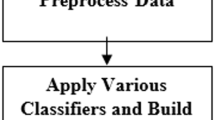Abstract
Data mining is being used in various fields to dig out important information; it can be very effective in the field of education as well for gaining important information from a large dataset that can be used to improve the educational environment. This paper is focused on an approach consisting of several well-known and widely used algorithms on training data set to predict students’ grade for a particular course based on his/her previous results. Further analysis has been carried out considering several errors and accuracy factors of the resulted data in comparison with the actual data.
Access this chapter
Tax calculation will be finalised at checkout
Purchases are for personal use only
Similar content being viewed by others
References
Baradwaj, B.K., Pal, S.: Mining educational data to analyze students’ performance. arXiv preprint arXiv:1201.3417 (2012)
Zain, J.M., Herawan, T.: Data mining for education decision support: a review. Int. J. Emerg. Technol. Learn. 9(6), 4–19 (2014)
Osmanbegovic, E., Suljic, M.: Data mining approach for predicting student performance. Econ. Rev.: J. Econ. Bus. 10(1), 3–12 (2012)
Oyedotun, O.K., Tackie, S.N., Olaniyi, E.O., Khashman, A.: Data mining of students’ performance: Turkish students as a case study. Int. J. Intell. Syst. Appl. 7(9), 20 (2015)
Minaei-Bidgoli, B., Kashy, D.A., Kortemeyer, G., Punch, W.F.: Predicting student performance: an application of data mining methods with an educational web-based system. In: 33rd Annual Frontiers in Education, 2003, FIE 2003, vol. 1, pp. T2A–13. IEEE (2003)
Pandey, U.K., Pal, S.: Data Mining: A prediction of performer or underperformer using classification. arXiv preprint arXiv:1104.4163 (2011)
Mueen, A., Zafar, B., Manzoor, U.: Modeling and predicting students' academic performance using data mining techniques. Int. J. Mod. Educ. Comput. Sci. 8(11), 36 (2016)
Bhargava, N., Sharma, G., Bhargava, R., Mathuria, M.: Decision tree analysis on j48 algorithm for data mining. Proc. Int. J. Adv. Res. Comput. Sci. Softw. Eng. 3(6), 1114–1119 (2013)
Aljazzar, H., Leue, S.: K*: a heuristic search algorithm for finding the k shortest paths. Artif. Intell. 175(18), 2129–2154 (2011)
Yiu, T.: Towards data science-understanding random forest (2019). https://towardsdatascience.com/understanding-random-forest-58381e0602d2
Glen, S.: “RMSE: Root Mean Square Error” From StatisticsHowTo.com: Elementary Statistics for the rest of us! https://www.statisticshowto.com/probability-and-statistics/regression-analysis/rmse-root-mean-square-error/
Glen, S.: “Relative Absolute Error” From StatisticsHowTo.com: Elementary Statistics for the rest of us! https://www.statisticshowto.com/relative-absolute-error/
“Analyzing genexprotools models statistically,” https://www.gepsoft.com/gxpt4kb/Chapter10/Section2/SS15.html
Kira, K., Rendell, L.A.: A practical approach to feature selection. In: Sleeman, D.H., Edwards, P. (eds.) Ninth International Workshop on Machine Learning, pp. 249–256. Morgan Kaufmann (1992)
Kononenko, I.: Estimating attributes: analysis and extensions of relief. In: Bergadano, F., Raedt, L.D. (eds.) European Conference on Machine Learning, pp. 171–182. Springer (1994)
Hirai, M., Kawai, S.: False positive and negative results in allen test. J. Cardiovasc. Surg. 21(3), 353–360 (1980)
Lewis, H., Brown, M.: A generalized confusion matrix for assessing area estimates from remotely sensed data. Int. J. Remote Sens. 22(16), 3223–3235 (2001)
“WEKA The workbench for machine learning”. https://www.cs.waikato.ac.nz/ml/weka/
Author information
Authors and Affiliations
Corresponding author
Editor information
Editors and Affiliations
Rights and permissions
Copyright information
© 2021 The Author(s), under exclusive license to Springer Nature Switzerland AG
About this paper
Cite this paper
Sarwar, H., Das Gupta, D., Luna, S.M., Suhi, N.J., Tasnim, M. (2021). Result Prediction Using Data Mining. In: Arai, K. (eds) Intelligent Computing. Lecture Notes in Networks and Systems, vol 284. Springer, Cham. https://doi.org/10.1007/978-3-030-80126-7_23
Download citation
DOI: https://doi.org/10.1007/978-3-030-80126-7_23
Published:
Publisher Name: Springer, Cham
Print ISBN: 978-3-030-80125-0
Online ISBN: 978-3-030-80126-7
eBook Packages: Intelligent Technologies and RoboticsIntelligent Technologies and Robotics (R0)




